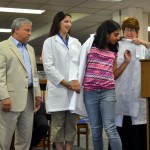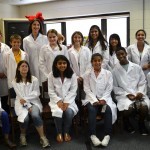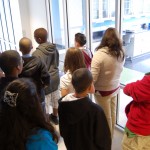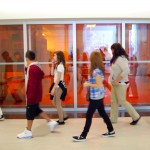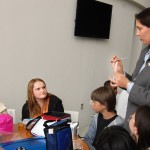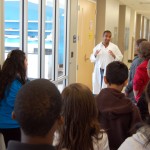A team of 14 middle school students will test mold growth on the International Space Station
Greensboro, N.C. – A team of student scientists from Johnson Street Global Studies is interested in finding out how long it would take food to spoil in outer space. If the team finds that mold grows differently in microgravity, its research could help determine what passengers will eat if public space travel ever becomes a reality.
Fourteen students will have the opportunity to study mold growth by placing their experiment on the International Space Station this fall. As a part of the Student Spaceflight Experiments Program, they will be among some of the first researchers to send an experiment to the space station via a commercial spacecraft. Johnson Street is one of 11 student teams from across the country selected to fly an experiment on the first operational flight of the SpaceX Dragon, scheduled for launch in September 2012.
During the spaceflight, the student team will conduct two identical experiments – one on the International Space Station and one in their classroom – to see how gravity effects mold growth. Sixth-graders Evelyn Adriance, Ryan Darden, Zeynab Warrich and seventh-grader Jonathan Mickey, the principal investigators for the experiment, said they expect to find less mold growth in outer space since there is less gravity.
The team’s advisors, Alison Manka and Suzanne Bahr, science teachers at Johnson Street, said the students brainstormed ideas and worked on their experiment proposal twice a week for a month.
“I am swelling with pride,” said Manka. “This is an incredibly hard thing to do. Our students are seeing what real science is like and will get to create a real experiment. They will do the same things that universities and professional researchers do. Sending an experiment to the International Space Station takes our school’s global studies curriculum to a whole new realm.”
The Johnson Street experiment was selected from 32 proposals submitted by students from four Guilford County middle schools, including Ferndale Middle, Mendenhall Middle and Northeast Middle.
A local committee of 35 community members, university representatives, science professionals and Guilford County Schools (GCS) educators selected the top three experiments. A national review board convened by the National Center for Earth and Space Science Education, which administers the program, selected Johnson Street’s experiment for spaceflight. The other finalists were a cell mitosis experiment by Ferndale Middle and a paint absorption experiment from Mendenhall Middle.
Two student-designed mission patches will fly with the experiment. The artwork for the patches was created by sixth-grader Madeline Cassetty from Northwest Middle and 10th-grader Alexa Sassorossi from Northern High. The patches will be certified as having flown in space and returned for display in their respective schools.
Grants and contributions of $20,000 from the N.C. Space Grant, John G.B. Jr. and Jane R. Ellison Family Foundation, Community Foundation of Greater Greensboro, GCS Enrichment Fund and the PTAs of the four schools involved are making the experience possible.
In addition to the students who are the principal investigators of the experiment, members of the Johnson Street team are sixth-graders Mary Dumena, Yodit Getahun and Jamarria Haywood, seventh-graders Aya Abdelaziz, Jamie Baxter, Tavin Felton, Ashka Shah, Summer Shoemake and Mookho Htee, and eighth-grader Ashley Sowell.
This is the second time GCS will participate in the Student Spaceflight Experiments Program. In 2011, a team from Mendenhall Middle designed an experiment about the effect of gravity on brine shrimp. The experiment was selected to fly on the final mission of Space Shuttle Endeavour.
The Student Spaceflight Experiments Program is a national science, technology, engineering and math (STEM) program undertaken by the National Center for Earth and Space Science Education in partnership with NanoRacks LLC, which is working with NASA under a formal Space Act Agreement as part of the utilization of the International Space Station as a National Laboratory.
 SSEP National Blog
SSEP National Blog
